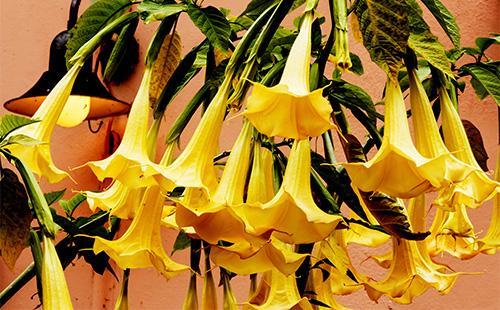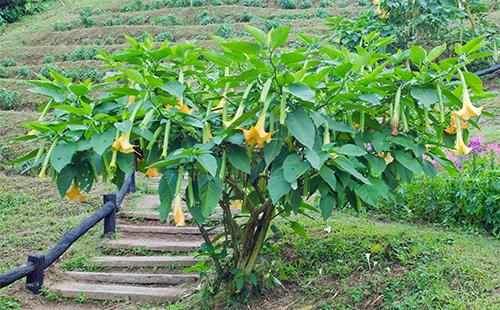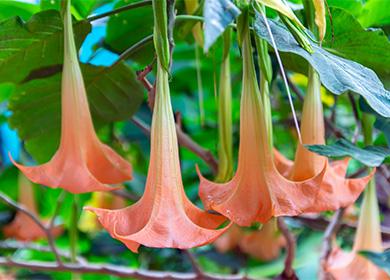The content of the article
Brugmansia is popularly called "angel trumpets" for the unusual shape of the flowers. As a houseplant, Brugmansia is rarely used - because of its large size, it can be seen more often in open ground in flower beds. But some varieties feel good in a spacious apartment.
Botanical Description
The leaves of Brugmansia are large, with pronounced central veins. The shape is oval, with smooth edges. In nature, the length of the leaves reaches half a meter. The leaves are large in the lower part of the bush, and small in the upper part.
The flowers are bell-shaped, large, with a pronounced aroma. The colors are different, mostly warm shades. There are hybrid varieties with terry and bunk flowers. Different shades are often combined on one bush. Brugmansia flower is sometimes called the "tree of the devil." This is due to the fact that earlier the plant was attributed to the genus Datura.
Popular varieties
Not all varieties of Brugmansia are suitable for growing in an apartment. Many of them grow greatly, become stunted in cramped conditions. For planting in tubs, compact varieties are chosen. Five types of Brugmansia are best known in culture.
- Fragrant. A plant brought to our country from Brazil. It grows in nature in hot climates. Well suited for growing in apartments. When creating favorable conditions, it can bloom almost all year round. In the natural environment reaches enormous size - grows to five meters. The flowers are white or light, with a slight greenish tint, large.
- Golden. It is distinguished by long and large leaves. Blossoms in beautiful yellow-orange flowers.
- Snow white. A tree species with large snow-white flowers. In nature, grows up to three meters. In room culture, compact hybrid varieties are used.
- Bloody. Large, frost-resistant shrub with flowers of a saturated orange or red hue. During flowering exudes a pleasant aroma.
- Multi-colored. Valued for unusual flowering. Freshly blossomed flowers are painted white; they become peach or orange as they mature. In nature, multi-colored brugmansia reaches four meters, and flowers - half a meter in length.
Care for Brugmansia: what to consider
Brugmansia is considered a relatively unpretentious plant. It grows rapidly, blooms profusely. You can achieve year-round flowering, if you strictly follow the recommendations of experienced gardeners.
- Lighting. Photophilous plant. If the apartment does not have enough light, it is better to cut off the brugmansia for the winter, and put it in a cool place. For example, in the basement. Another option is to organize artificial lighting with fluorescent lamps. In summer it is advisable to keep on the open balcony, or often ventilate the room.
- Temperature. He likes moderate heat, withstands heat well. The optimum temperature range in the summer is 23–25 ˚С. Cooling below 5 ° C leads to the death of the plant. There is only one way to save Brugmansia in winter when grown in open ground: dig in the fall, cut it, and put it into the basement until spring.
- Watering. In the spring-summer period watered abundantly and often - large leaves actively evaporate moisture. With the beginning of flowering, growth stops, the intensity of irrigation is slightly reduced. The frequency and abundance of watering in winter depends on the conditions of detention. With a warm wintering they are guided by the speed of soil drying. In the cold period of rest, the amount of moisture introduced is minimized.
- Humidity. Spraying Brugmansia is needed only in the summer heat. The rest of the time it normally adapts to low humidity.
- The soil. Brugmansia grows rapidly, consumes a lot of nutrients, it needs a nutritious, loose soil. From store mixtures, a substrate for palm trees is preferred. Independently, the soil is prepared from humus, peat and sand.
- Transfer. At first, a young plant has to be replanted several times a year due to rapid growth. In an adult plant, the need for transplants is lower. A little chicken droppings or a handful of mineral fertilizer in granules are added to the soil during transplantation.
- Top dressing. In the period of active growth and flowering, balanced mineral fertilizers are applied weekly for flowering indoor crops. Sometimes you can feed Brugmansia with organics.
- Pruning. Regulatory pruning is done every summer. All wilted flowers and part of the stepsons are removed. On too thick bushes, flowers and leaves fade. After the autumn pruning, before wintering, the tops of the shoots remain - they can be used as cuttings.

Breeding methods
The easiest way to propagate Brugmansia by cuttings. But seed reproduction is often used. These methods are effective and simple - even a beginner can grow brugmansia. Both breeding options are discussed below.
Cuttings
The best time for grafting is spring or autumn. Rooting cuttings is not difficult, but it is better to cut them with a margin, so that later you can choose the strongest plants. Rooting is carried out according to a certain scheme.
- Cutting cuttings. Cut the tops of the annual lignified shoots. A prerequisite is a full, intact growth point. Two or three buds are left on each handle. Large leaves are pruned.
- Root extension. A little water is poured into an opaque container, two tablets of activated carbon are added to it. Cuttings are dipped tips in water, put in a bright, relatively warm place. A favorable temperature for the appearance of roots is about 20 ° C.
- Disembarkation. After about two to three weeks, after the appearance of the roots, the cuttings are planted in moist, loose soil. A peat-based substrate with the addition of perlite and sand is well suited.
Seeds
Brugmansia from seeds at home grows more slowly, when using planting material from your plant, bright varietal characteristics are often lost. To obtain healthy, strong seedlings, follow the following sequence of actions.
- Seed preparation. The optimal period for sowing is from January to March. Pre-soaked seeds for a day in any growth stimulator.
- Sowing. Prepare the soil - a normal garden soil with neutral acidity will do. The container is filled with a substrate, slightly moistened and compacted. Seeds are evenly laid out on the surface, sprinkled with a layer of earth about 1 cm.
- Germination conditions. The container is covered with glass, put in a bright place, maintain a temperature of 20-25 ˚С. Periodically, the soil is moistened, the greenhouse is aired. Depending on the freshness of the seeds, inputs appear after one to six weeks.
- Seedling Care. As soon as the shoots appear, the glass is removed. Seedlings are sprayed daily with warm water, but do not allow overmoistening of the soil.
- Seating. After the fifth true leaf appears, a pick is carried out. Seedlings can be planted in a larger box or immediately in separate pots.
Common florist errors
As a result of errors in care and maintenance, the decorativeness of Brugmansia is reduced, flowering is sparse and short-lived. If the plant has yellowed leaves, growth has slowed or buds fall, study the information in the table.
Table - Florist Errors
| External manifestations | Possible reasons | Help the plant |
|---|---|---|
| Leaves fall | - lack of moisture | - Watered abundantly and regularly taking into account the temperature of the content |
| Shoots stretch, become thin, leaves turn pale | - Poor lighting | - The pot is rearranged on the east or west window; - install fluorescent lamps |
| Growth is slowing down | - Reaching the plant growth limit; - lack of nutrition | - Regularly fed balanced fertilizer |
| Buds fall | - lack of moisture; - temperature differences; - a sharp change in conditions of detention | - Regulate the watering mode; - provide good lighting |

Diseases and Pests
Brugmansia is disease resistant, but sometimes you have to deal with rot. Dense soil, lack of drainage, systematic waterlogging of the soil leads to decay in most cases. Less commonly, rot is fungal in nature. In both cases, the treatment is the same. Brugmansia is removed from the pot, rotted roots are cut, treated with fungicide, and then planted in new soil. Sometimes you have to chop and root healthy cuttings to replace a diseased plant.
Despite the toxicity of Brugmansia, it is often affected by pests. The most common and dangerous pests for the flower are described in the table.
Table - Pests of Brugmansia
| Pest insect | Symptoms of occurrence | Methods of struggle |
|---|---|---|
| Weevil | - Eroded areas appear on the edges of foliage and petals; - unopened buds fall | - Each week, insecticides are treated until insects disappear completely |
| Whitefly | - Leaves turn yellow, fall off; - the plant looks lethargic | - Use special traps for whiteflies; - sprayed with an insecticide |
| Aphid | - Twisted tops of shoots; - sticky coating appears on young leaves; - colonies of greenish insects form | - Wash Brugmansia with a sponge dipped in soapy water; - sprayed with tobacco dust infusion |
| Spider mite | - Light dots appear on the leaves, gradually they merge into large colorless areas; - a cobweb forms on the back of the leaves | - Increase humidity in the room; - sprayed with the drug "Actara" |
| Slugs and snails (with street content) | - holes form on the leaves | - Spray with the insecticides Actellik, Iskra, Fitoverm |
Growing brugmansia at home is a good solution for owners of spacious apartments. The flower forms a fairly large bush, in the summer it needs fresh air, so you need to evaluate whether you can provide it with the necessary conditions.

